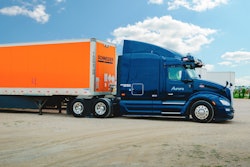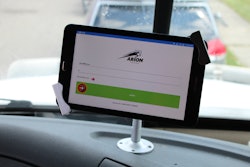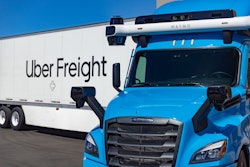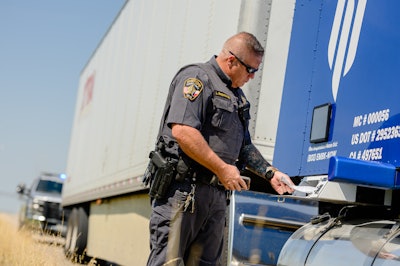
One of the most consistent questions surrounding autonomous trucking is rooted in how a driverless truck interacts with law enforcement when the responsibility of navigating a traffic stop – from pulling over to handing over paperwork – is a very people-to-people transaction.
Working in conjunction with the Texas Department of Public Safety and the Travis County Sheriff’s Office, autonomous trucking technology company Embark Trucks said it developed the capability for Embark-powered semis to identify and stop for law enforcement vehicles; built communication protocols and standard operating procedures between autonomous trucks and officers; and recently completed the first known public demonstration of an autonomous truck being pulled over by law enforcement and participating in a routine traffic stop on a public highway.
“The ability to engage safely in emergency vehicle interactions is necessary to operate an autonomous vehicle on public roads,” said Emily Warren, Embark Trucks head of public policy. "Law enforcement always needs to be able to stop a commercial vehicle – autonomous or not – to ensure compliance with the law. This capability was designed to work seamlessly within existing law enforcement workflows, without requiring new training or technology investment by first responders.”
An Embark spokesperson told CCJ that the company's autonomous driving software – Embark Driver – is designed to comply with all traffic laws, "so we don’t expect Embark-powered trucks to be pulled over regularly." However, law enforcement has the authority to execute a routine traffic stop on any vehicle operating on a highway "and our system must be able to accommodate that. Situations that could require a pullover might include an officer observing a burned-out tail light or a damaged reflector that became inoperable after the truck began its haul that day."
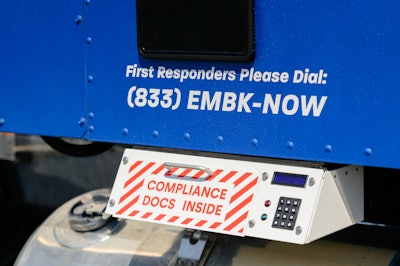 Embark’s externally accessible lockbox, containing information such as registration and bills of lading, as well as a toll-free number to contact an Embark Guardian support technician, are also included in the company’s plans to assist law enforcement officers as they perform roadside traffic stops.
Embark’s externally accessible lockbox, containing information such as registration and bills of lading, as well as a toll-free number to contact an Embark Guardian support technician, are also included in the company’s plans to assist law enforcement officers as they perform roadside traffic stops.
Embark's engineering team then developed an interaction procedure with input from law enforcement that can enable any law enforcement officer to safely stop, approach and receive information from an autonomous truck without additional equipment. When commercially deployed, this effort may include outfitting Embark trucks with clear visual cues and information to signal to law enforcement and other first responders that an Embark-powered truck is an autonomous vehicle and has come to a safe stop with no risk of restarting unexpectedly. Embark’s externally accessible lockbox, containing information such as registration and bills of lading, as well as a toll-free number to contact an Embark Guardian support technician, are also included in the company’s plans to assist law enforcement officers as they perform roadside traffic stops.
To develop this capability, Embark, TCSO, and Texas DPS executed comprehensive data collection and testing from April to June that included closed-course activity at the Texas A&M University RELLIS Campus test track as well as public road demonstrations. During Embark’s industry-first demonstration, which took place in late June on Texas State Highway 130 near Austin, deputies from the TCSO’s Commercial Vehicle Enforcement division followed an Embark-powered truck along a designated route and successfully completed a traffic stop of the Embark truck.
A deputy was able to confirm the truck was safe to approach via an external status display on the side of the truck, then walked through the procedure of accessing the truck’s documentation via an external lockbox, using a code that would be provided by a remote Embark Guardian support technician. The demonstration concluded after the deputy completed his traffic stop and followed the truck as it re-entered highway traffic.
"Once the Embark team addresses the issue for which the truck was pulled over, the truck would remotely be directed to resume its journey," said the spokesperson. "If there is an issue that prevents resuming (such as out of service criteria), the truck will be retrieved from the side of the road by our operations team. If resuming, the truck pulls safely back onto the road."
During the live test, an Embark safety driver was inside the cab, but in the eventuality that person is removed and the entire experience goes completely driverless, it's only a matter of time before would-be cargo thieves invest in red and blue dash lights. Embark said it's already thought of that.
"A pullover request also alerts Embark's remote Guardian support technicians who monitor the trucks on their hauls," an Embark spokesperson told CCJ. "The Guardian support technician would be able to identify false positives or deceptive behavior and confirm a pullover request. The Guardian support technician can call the appropriate jurisdiction and easily confirm whether or not this is a real officer."
Embark’s technical capabilities roadmap includes 16 capabilities the company believes are required to commercially deploy autonomous trucks in the U.S. Sunbelt, and the completion of this successful public demonstration marks the achievement of 12 of the 16 milestones.




